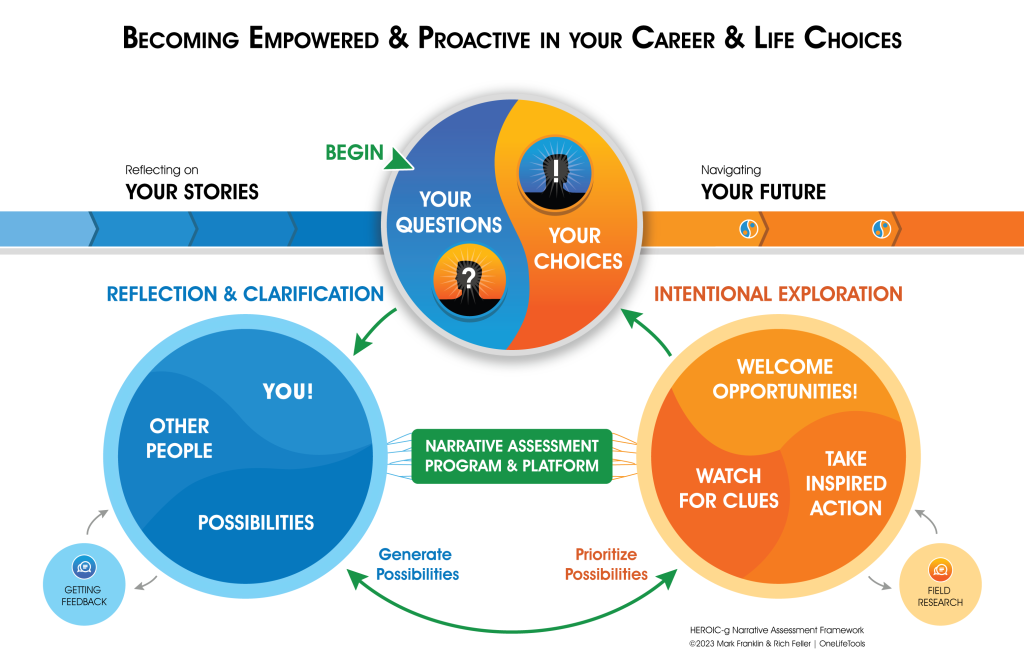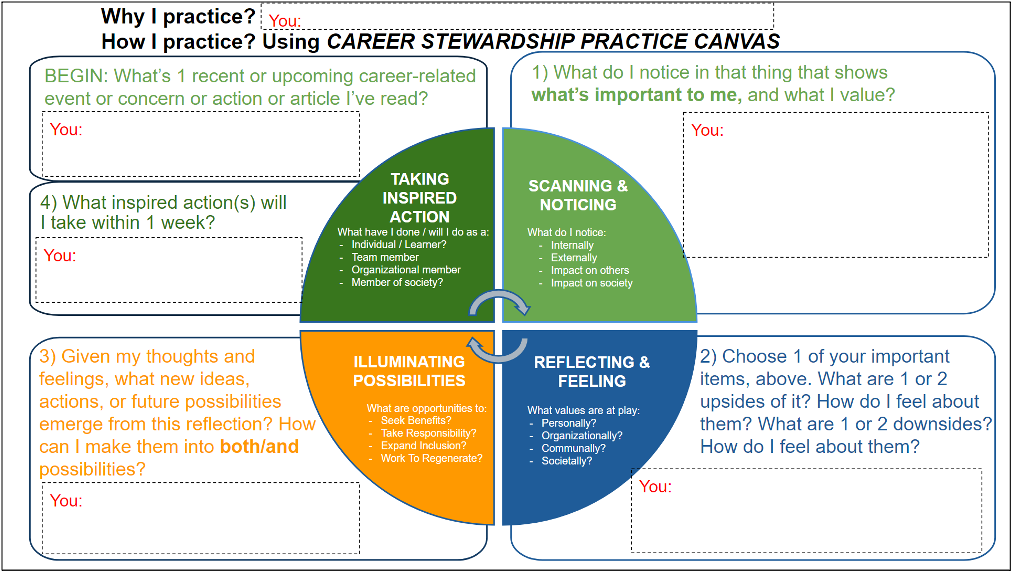|
Getting your Trinity Audio player ready...
|
What does it mean to have a practice of “career stewardship”? We propose that career stewardship is a layer above career management.
Career management is the ongoing process of navigating a lifetime of transitions, which links your desires, strengths, personal qualities, interests, influences and assets to career opportunities aligned with who you are. This aligns with the holistic career definition: “The full expression of who you are and how you want to be in the world, which keeps on expanding as it naturally goes through cycles of stability and change” (Franklin, 2013).
Doing well vs. doing good
A common challenge in career management is a tension between desires to do well and do good. To address this tension, we introduce the term career stewardship defined as: “a values-centred approach and movement that empowers individuals and organizations to better navigate tensions between doing well and doing good, inherent in career management, resulting in careers that are more fulfilling and positively impactful.” This definition is inspired by parallel work in “tech stewardship” which aims to make technology beneficial for all by navigating values tensions between feasibility and ethics, e.g. can we do it vs. should we do it.
Doing well is about finding and achieving a sense of comfort and well-being in one’s lifestyle, often linked to having enough resources to satisfy wants and needs.
“A common challenge in career management is a tension between desires to do well and do good.”
Doing good is about having a positive impact on people and/or the planet such as advancing the United Nations Sustainability Development Goals (SDGs). “Effective altruism” is a movement that seek better ways to do good – for example, a focus on earning in order to donate to worthy causes, rather than directly working for the worthy cause.
Many career clients say that they want to make a positive difference, to work toward solving societal problems – from environmental degradation to climate change to creating AI accountability and transparency. For many, there’s a tension between making that positive impact and doing well in life and lifestyle. They see it as an either-or dilemma.
Supporting career management clients to find both-and solutions
How can we support clients to find both-and solutions of doing well and doing good? Is it possible to do well financially and make a positive difference in the world? How can we help clients find solutions as they, their sectors and the world evolve? Effective, even transformative, reflective practices are required.
To help clients navigate transitions and effectively manage their careers, we developed the evidence-based HEROIC-g Narrative Framework (Franklin, Yanar & Feller, 2015). This acronym for Hope, Efficacy, Resilience, Optimism, Intentional Exploration, Clarity, growth mindset is a qualitative form of career management in which over 2,500 career professionals have trained. Several programs, including credit-bearing courses at University of Toronto (Stebleton, Franklin et al., 2019) and Conestoga College, and hundreds of non-credit programs have embedded this narrative method. See Figure 1.

To help clients move from questions to choices, clients pass through two processes. On the left, in blue, Reflection and Clarification is a narrative, reflective practice eliciting stories and experiences to systematically identify and aggregate desires, strengths, personal qualities, other people and client possibilities. The second process, on the right, in orange, is the fun and exciting process of Intentional Exploration.
Within the HEROIC-g narrative framework we use the term “Desires” to go beyond values, and describe what you want and what’s important to you. As career professionals listen to client stories, a skill we call “story-listening,” desires to do well emerge in phrases like, “I want a good lifestyle and decent income” and “I want to be able to start a family.” Desires associated with doing good sound like, “I want to make a difference” and “I would love to have a positive impact by helping to address [fill in the societal issue].”
Using the Career Stewardship Practice Canvas
Enter the Career Stewardship Practice Canvas as an add-on tool to any career management practice such as the HEROIC-g Narrative Assessment Framework. This tool helps clients move from either-or thinking to both-and “possibilities thinking,” which reveals options where they can do well and do good. Follow along with Figure 2, featuring an example. We crafted this tool for clients and professionals to launch and maintain a regular practice of career stewardship.

Career stewardship practice is triggered when one experiences a recent or upcoming career-related event, concern, action or article you read. For example, I’m going to the next Cannexus conference as a speaker, delegate and exhibitor.
Step 1: scanning and noticing. Ask yourself, “What do I notice in that event, concern, action or experience that shows what’s important to me?” In the example, what is important to me is: Learning and growing as an individual. Building and growing relationships. Reaching a tipping point for narrative tools. Adventure.
Step 2: reflecting and feeling. Choose one important item from Step 1. Ask yourself, “What are one or two upsides of it? How do I feel about them? What are one or two downsides? How do I feel about them?” For example: For “Reaching a tipping point…” Two upsides are better practitioner experiences; better client experiences and outcomes. I feel excited and eager. Two downsides are: it’s going to be hard work; there will be winners & losers. Which makes me feel tired, worried.
Step 3: illuminating possibilities. Given your thoughts and feelings, ask yourself, “What new ideas, actions or future possibilities emerge from this reflection? How can I make them into both-and possibilities?” For example, given my worry about winners and losers, I can focus on telling the story of integration of assessments into the narrative approach, which sidesteps the winners/losers polarity and provides a both-and solution.
Step 4: taking inspired action. Ask yourself, “What inspired action(s) will I take within one week?” For example, within one week I will identify three assessments to show integration in a show-and-tell slide series for Cannexus.
Practice is defined as the actual application or use of an idea, belief or method, as opposed to theories relating to it. It is the act of doing something regularly or repeatedly to improve skill level (Oxford & Cambridge dictionaries). Using the Career Stewardship Practice Canvas within career sessions transforms the idea of stewardship into application. By using it regularly, one creates ‘muscle memory’ and builds both-and solution finding skills.
When promising both-and possibilities emerge from moving through the career stewardship steps, clients can follow the clues, take inspired action and welcome better opportunities to navigate cycles of stability and change.
Resources




